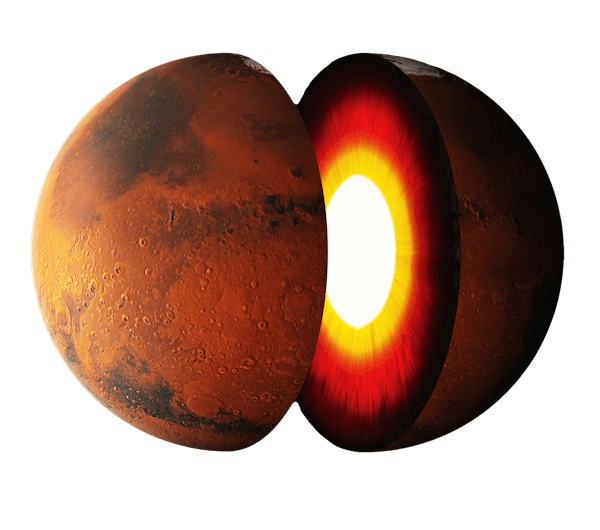
molten metal molten metal molten metal molten metal
Marsquakes reveal the ultra metal nature of the Red Planet's core
NASA Mars InSight researchers confirmed this year that Mars has a liquid metal core like Earth, which could be the source of Marsquakes that shake the Red Planet.
by Elana SpivackMars science discoveries can be so superficial — the search for water caches, terrestrial sampling, and other technical marvels tend to take place on the surface of the Red Planet (or a little above it). But while NASA’s Perseverance rover scoots around in Mars’s dust and gravel, there’s plenty deep within the planet itself that’s worth learning about, too. Like the fact that Mars’ inner core is perhaps the most metal place on the entire planet.
The discovery — Earlier this year, three papers published in the journal Science confirmed that Mars’ core is made of molten metal. The finding came as a result of recording Marsquakes — the Martian equivalent of earthquakes here on Earth.
Mark Panning, the JPL project scientist for NASA’s InSight lander, and his colleagues drew from seismometer data to find the thickness and potential structure of the planet’s crust, the temperature of the planet’s mantle, and make the first direct seismological confirmation of the planet’s core — hence the trio of papers.
INVERSE is counting down the 20 science discoveries that made us say “WTF” in 2021. This is #7. See the full list here.
How they did it — Scientists know about Earth’s insides as a result of seismology — basically studying earthquakes and other internal rumblings as a means to peer at the processes driving them — but this method hasn’t really been an option for researchers studying other planets until very recently.
Then in 2018, a seismometer landed on Mars as part of the NASA InSight (Interior Exploration using Seismic Investigations, Geodesy and Heat Transport) mission — and it has been recording Marsquakes ever since.
The point of this mission is to suss out Mars’s inner structure through seismological and thermal readings taken from a point on a plane along the Martian equator, called Elysium Planitia.
Digging into the details — In the study of Mars’s core, InSight detected a type of seismic wave called an S-wave, but these waves were bouncing off the planet’s core — making them ScS waves, to use the scientific lingo. By tracking the waves and making other measurements, the researchers found Mars’ core has a radius of about 1,800 kilometers and it is liquid. Very much like Earth’s, in fact.
“A solid core would not have produced a strong enough reflection for us to have seen it,” Panning explained at the time.
“The fact that we recorded it confirmed that the core is liquid.”
InSight and its tiny “mole” heat probe friend are seen in this illustration.
In all the studies, the researchers had to search for the signals they needed — it seems like Marsquakes are not so strong as earthquakes can be, at least according to these data.
“None of these events are big,” Panning says. “The biggest event we’re looking at is maybe a magnitude 3.8,” he says. In California, where Panning’s based, “there’s a really good chance you wouldn’t even feel it, depending on how close you are.”
The extraordinary sensitivity of InSight’s seismometer can clock vibrations on the scale of a hydrogen atom, so its measurements are reliable. That Mars is dry and lacks Earth’s noisy oceans helps, too.
InSight also measured the two layers above the core: Mars’s mantle and crust. Understanding Mars’s interior composition is so important because it will help us understand how other rocky planets formed and evolved. The planet we happen to live on is also a rocky planet.
InSight will continue its mission into 2022, digging deeper for answers and recording more Marsquakes. And if we ever learn enough about Mars, the good news is there are two more rocky planets relatively close by for us to investigate.
INVERSE is counting down the 20 science discoveries that made us say “WTF” in 2021. This is #7. Read the original story here.
This article was originally published on